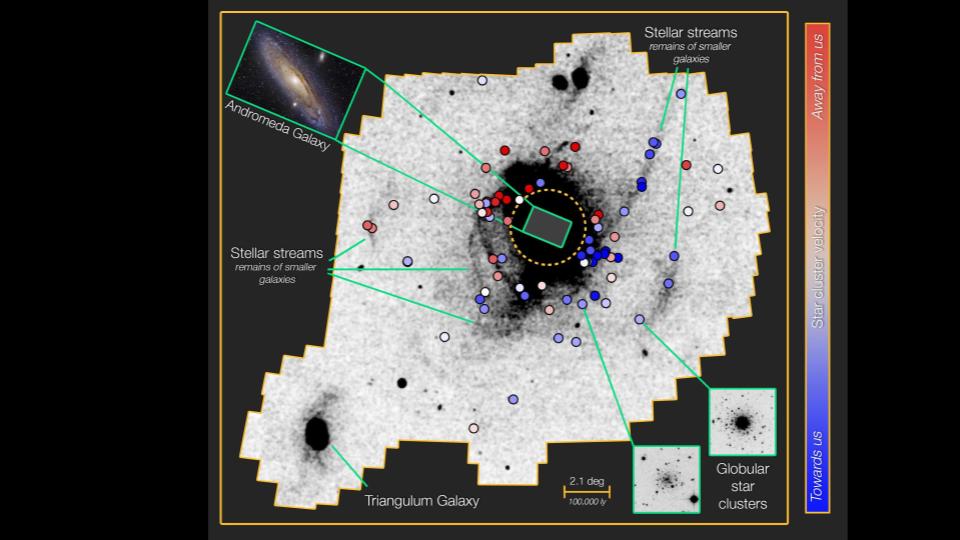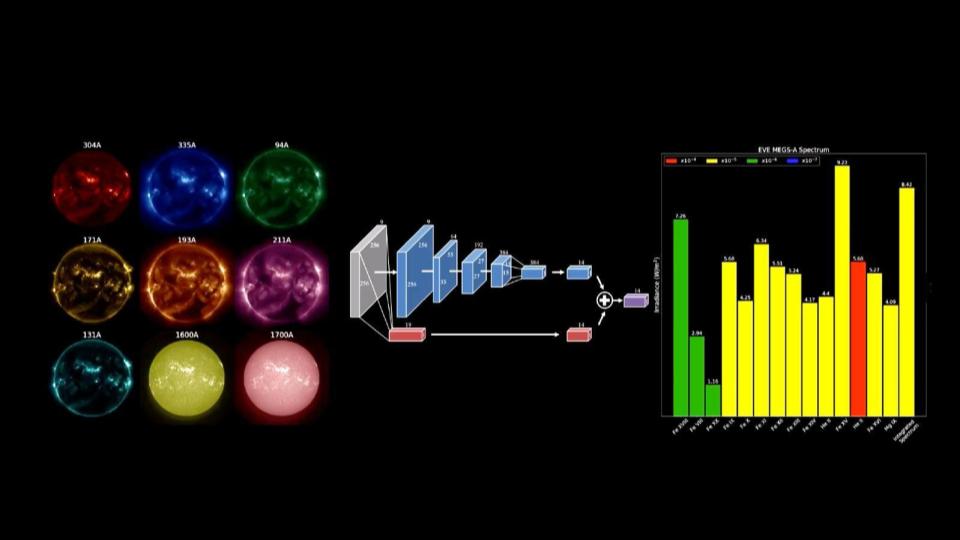Astronomers have found the debris left behind when Andromeda fed on two galaxies. Listen to learn more, and also get updates on orbital changes for Juno, and how Deep Learning may offer a replacement for the Extreme Ultraviolet instrumentation used to predict space weather.
Links
Andromeda Galaxy
- Two Ancient Migration Events in the Andromeda Galaxy (Press Release)
- The Andromeda Galaxy Has Been Devouring Other Galaxies Since It Was a Baby (And Earth Is Next) (Space.com)
- The violent history of the big galaxy next door (Science Daily)
Predicting the Sun’s activity with Deep Learning
- NASA Frontier Development Lab Uses Deep Learning to Monitor the Sun’s Ultraviolet Emission (SETI Institute)
- A deep learning virtual instrument for monitoring extreme UV solar spectral irradiance (Science Advances)
Juno spacecraft Update
- NASA’s Juno Prepares to Jump Jupiter’s Shadow (Press Release)
- NASA’s Juno Mission Checks Out Epic Io Eclipse on Jupiter (Space.com)
Marsquakes (In the video version, this segment was also covered)
- NASA’s InSight ‘Hears’ Peculiar Sounds on Mars (Press Release)
- InSight Has Already Detected 21 Marsquakes (Universe Today)
- ‘Dinks and Donks’ and Marsquakes: Hear Weird Red Planet Sounds from a NASA Lander (Space.com)
Transcript
This is the Daily Space for today, Thursday, October 3, 2019.
Most Mondays through Fridays, either I or my cohost Annie Wilson will be here bringing you a quick rundown of all that is new in space and astronomy. We’ve been doing this podcast version of our longer-running Twitch series for 2 weeks now, and we’re so grateful to all you who have already joined us. If you like what you hear, we’d love it if you could share our show with others. You never know whose life you are going to change by introducing them to science.
———————

The globular clusters studied (lower right insets), indicated by colored circles, are located in the outer halo of the Andromeda Galaxy, beyond the bright disk of the galaxy (upper left inset). The star clusters separate into two groups — those associated and unassociated with stellar streams — that have very different orbits, a result that points to two discrete migration events in the history of the galaxy. The color of each circle indicates the line-of-sight velocity of the corresponding star cluster.
Credit: Australian National University / NSF’s National Optical-Infrared Astronomy Research Laboratory
In today’s first story, we take an in-depth look at the Andromeda galaxy and its surroundings. When we think of Andromeda, the image that comes to mind for most of us is disk and spiral galaxy that has appeared on so many calendars, posters and mugs. This beautifully formed spiral is just the luminous core embedded inside a much larger and messier cloud of gas, dust, and star clusters. In a new study appearing in the journal Nature, astronomers used the 4-meter Mayall telescope at Kitt Peak national observatory, and the 8-meter Gemini telescope at Mauna Kea Observatory, to measure the motions of star clusters in this outer region. They found evidence that two of the visible streams of material appear to be moving at right angles to one another. One of these streams is rich in stars, and appears to be the result of an object similar in size to the Large Magellanic Cloud getting consumed by Andromeda a few billion years ago. The other stream is devoid of stars and appears to be even older, perhaps coming from an event that occurred many millions of years ago.
In general, most galaxies have grown over the history of the universe through the gradual accumulation of smaller systems into progressively larger systems, and this work helps us better understand how this process, one that is taking place in our own galaxy as well, can transpire over time.
———————

You never what can happen when you get just the right people together in one place. … But you can hope… Last summer an interdisciplinary team from NASA a variety of academic institutions, and industry partners put together a group of early career researchers in science and computer science and gave them a variety of problems to try and solve with artificial intelligence and machine learning algorithms. One of those problems was to accurately predict the Sun’s activity in extreme ultraviolet light. Currently, we can image this activity, as is shown here, using an instrument on board the Solar Dynamics Orbiter. Launched 9 years ago, this mission was only supposed to last 5 years and we’re on borrowed time. Instrument’s like its EUV instruments are necessary for predicting the kinds of space weather events that can damage spacecraft and effect the Earth’s power grid.
And this brings us back to hopes. It was hoped that the creative abilities of earlier career scientists and programmers could together find a way to use the kinds of images we can get from other instruments to predict what the Sun would look like in the EUV.
And it turns out that using deep learning algorithms, they were able to do this. And here is the magical thing about this software, it does better than models build on physics and because of the nature of how this kind of software works, we can’t really know exactly what factors it is using to make its accurate predictions. For now, we still have the EUV instrument on SDO, and this software can be tested in great detail, and refined where needed. This means, when the instrument or SDO finally fails or is retired, we will still be able to predict the kinds of space weather that require putting missions in safe mode and preparing the power grid.
———————

In other news, on Monday night and going into Tuesday, the Juno spacecraft performed an unprecedented 10.5 hour burn of its engines. This mission arrived to Jupiter back in 2011, and entered a highly elliptical 53 day orbit. The mission had originally planned to change this into a smaller, 14 day orbit, but there were concerns about the missions engines, so the mission has stayed in its larger orbit. Scientifically, nothing has changed for Juno except the mission timeline; it will still be able to accomplish all of the missions initial goals. What did change was how long the spacecraft could potentially spend in Jupiter’s cold dark shadow. Juno is a solar powered spacecraft. The orbit it is currently on has it whipping past the planet when it is close in, and then moving significantly more slowly when it is further away. The steady change in geometry of Jupiter, the Sun, and Juno’s orbit meant that Juno was about to spend the long slow portion of its orbit dwelling in Jupiter’s shadow. In fact, it was going to spend 12 hours in shadow, and… that would have been death to this spacecraft. During those 12 hours, the mission batteries would have died, the systems would have frozen, and in the end… no more Juno.
With the 10.5 hour engine burn, they consumed 160 pounds or 73 kilograms of fuel and accelerated by 126 mph or 203 kph. This put Juno into a new orbit that will allow it to pass right on the edge of Jupiter’s shadow, while avoiding actually passing into its shadow. From the vantage of the mission, the Sun will appear to pass directly beside the edge of Jupiter. I don’t know what imagery is planned, but I am hoping for some silhouetted images in the not too distant future.
———————

(In the video version, the segment below was also covered)
In our final story of the day, we would like to bring you the sounds of Mars. Now, the audio I’m going to play from you is greatly enhanced, and isn’t exactly what you would hear if you were on the red planet. What we have instead are the recordings of Mars Insight’s seismograph, which is able to capture the subtle vibrations of even a gentle breeze. In audio files released on Tuesday, we can hear the pings and dings of the metal around the seismograph contracting as it cools in the evening. Let’s take a listen.
In an additional pair of audio files, we can hear the vibrations of two small marsquakes, that had magnitudes of 3.3 and 3.7.
The seismograph was originally placed on Mars to help us understand the inner structures of this rocky world. This work is just starting, but one of the first things we’ve learned is that Mars has an outer crust that has gaps and hollows. We don’t have this on Earth, where water fills gaps that form in our planet’s crust. In this way, Mars is more like the moon, and shakes and rings more like the moon thanks to these gaps in its outer crust.
———————
Thank you all for listening. The Daily Space is produced by Susie Murph, and is a product of the Planetary Science Institute, a 501(c)3 non profit dedicated to exploring our Solar System and beyond. We are made possible through the generous contributions of people like you. If you would like to learn more, please check us out on patreon.com/cosmoquestx
I will now take your questions, and ask you to please at CosmoQuestX to help me find them in the chat. While you type them in, let me remind you that the Daily Space is a production of the Planetary Science Institute, and is hosted by myself and Annie Wilson.
Last week we launched a new podcast edition of this show. If you want a 10 minute, chaos free listen, click over to dailyspace.org and check it out. We are still working on getting it listed in podcast directories, but don’t worry, it will be there soon.
Each live episode of the Daily Space is archived on YouTube. If you miss an episode here on Twitch.tv, you can find it later on youtube.com/c/cosmoquest. These episodes are edited and produced by Susie Murph.
We are here thanks to the generous contributions of people like you who allow us to pay our staff a living wage. Every bit, every sub, and every dollar committed on Patreon.com/cosmoquestx really helps. If you can’t give financially, we really do understand, and there are other ways you can help our programs. Right now, the best way you can help is to get the word out. Let you friends know, share our channel to your social media, or leave a recommendation. You never know what doors you are opening.
We really wouldn’t be here without you – thank you for all that you do.


 We record most shows live, on Twitch. Follow us today to get alerts when we go live.
We record most shows live, on Twitch. Follow us today to get alerts when we go live.